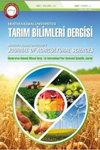亚湿润气候条件下大豆不同生育期满亏灌产量和品质的响应
IF 1.1
4区 农林科学
Tarim Bilimleri Dergisi-journal of Agricultural Sciences
Pub Date : 2016-06-08
DOI:10.1501/TARIMBIL_0000001375
引用次数: 24
摘要
本研究研究了大豆[甘氨酸max (L.)]的产量和品质响应。稳定。在半湿润气候条件下,在两年的时间里,在不同的生长阶段进行充分灌溉和亏缺灌溉。在营养(V)、开花(F)、结荚(P)和种子膨大(S) 4个关键发育阶段,分别施用1个雨养(不灌溉)处理和13个不同的灌溉处理(1个满灌和12个亏灌)。亏灌对大豆种子产量、原油含量、粗蛋白质含量和各项农艺参数均有显著影响。全灌(在整个生育期每隔7天从90 cm的土壤深度补充100%土壤水分)的种子产量最高(4004 kg ha-1),雨养处理的种子产量最低(1974 kg ha-1),全灌和雨养处理的平均产量差异为50.6%。雨养处理的粗原油含量最低(19.1%),粗蛋白质含量最高(33.6%)。因此,可以得出结论,虽然在当地条件下,VFPS处理可能是获得最大产量的最佳选择,但在水成本高和/或缺水时,应重新考虑灌溉计划;在这种情况下,可以采用包括营养发育阶段水分亏缺的灌溉计划。本文章由计算机程序翻译,如有差异,请以英文原文为准。
Yield and Quality Response of Soybean to Full and Deficit Irrigation at Different Growth Stages under Sub-Humid Climatic Conditions
This study investigated the yield and quality response of soybean [Glycine max (L.) Merr.] to full and deficit irrigation applied at different growth stages under sub-humid climate conditions over a two-year period. A rain-fed (non-irrigated) treatment and 13 different irrigation treatments (1 full and 12 deficit irrigations) were applied to soybeans at four critical development stages: vegetative (V), flowering (F), pod formation (P) and seed enlargement (S). Deficit irrigation had a significant effect on seed yield, crude oil content, crude protein content and various agronomic parameters. The highest seed yield (4004 kg ha-1) was obtained with full irrigation (based on the replenishment of 100% of soil water depletion from a soil depth of 90 cm at 7-day intervals throughout the development period) and the lowest (1974 kg ha-1) with the rain-fed treatment, with a 50.6% difference in average yield between full irrigation (VFPS) and rain-fed treatments. The rain-fed treatment also resulted in the lowest crude oil content (19.1%) and the highest crude protein content (33.6%). As a result, it may be concluded that while VFPS treatment may be the best choice for maximum yield under local conditions, irrigation schedules should be reconsidered when water cost is high and/or water is scarce; in such cases, an irrigation schedule that includes water deficit at the vegetative development stage can be applied.
求助全文
通过发布文献求助,成功后即可免费获取论文全文。
去求助
来源期刊
CiteScore
1.40
自引率
0.00%
发文量
26
期刊介绍:
Journal of Agricultural Sciences (JAS) is an international, double-blind peer-reviewed, open-access journal, published by the Faculty of Agriculture, Ankara University. The journal invites original research papers containing new insight into any aspect of Agricultural Sciences that are not published or not being considered for publication elsewhere. Preliminary, confirmatory or inconclusive research, review articles, case and local studies and works presenting taxonomy will not be published.

 求助内容:
求助内容: 应助结果提醒方式:
应助结果提醒方式:


